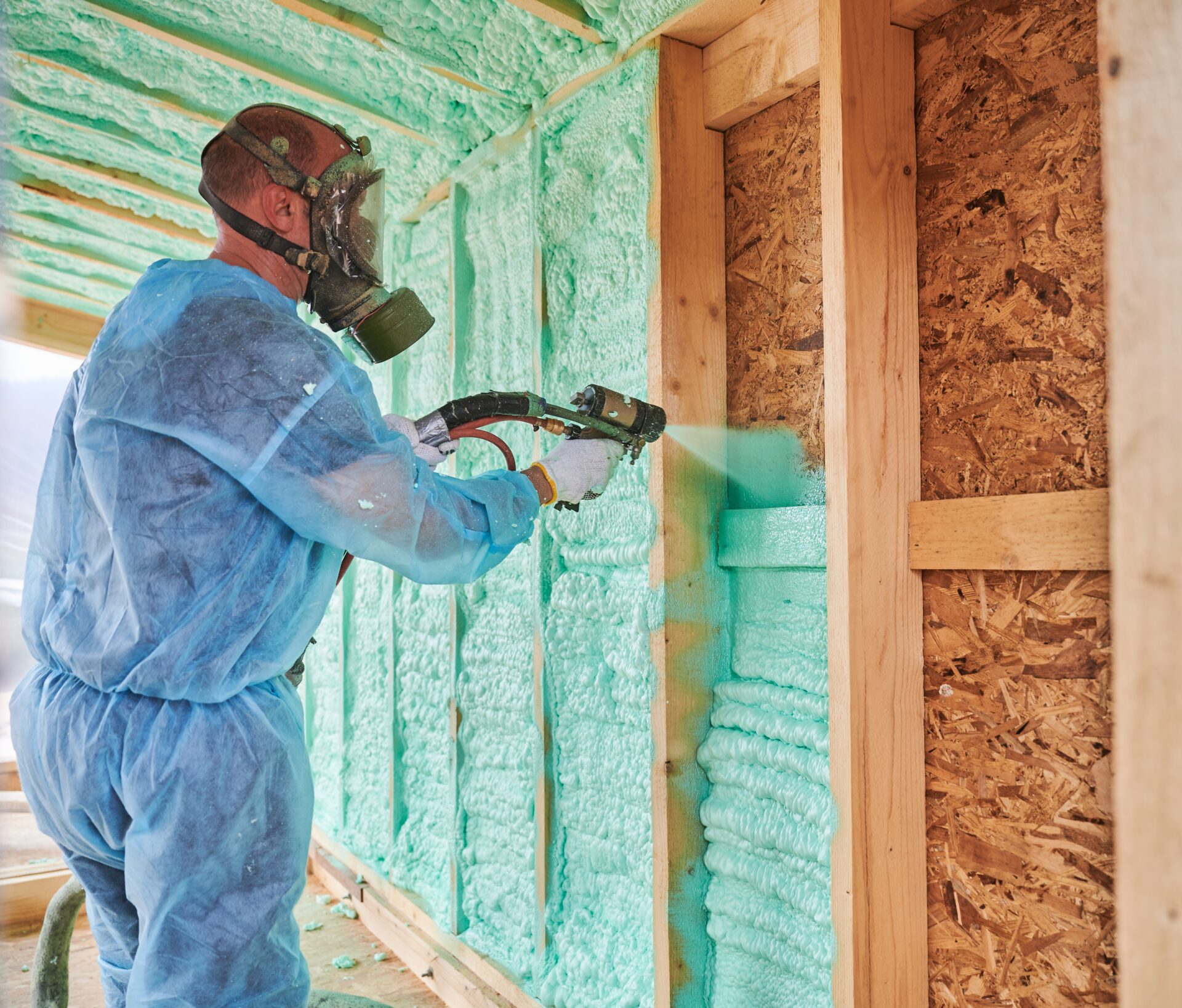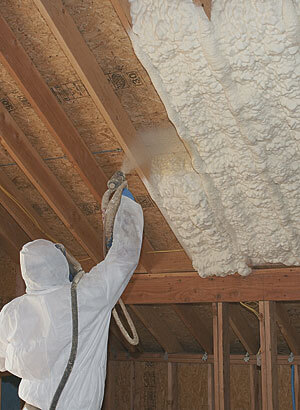Comprehending the Benefits of Using Spray Foam for Insulation Projects
Wiki Article
Spray Foam: The Ultimate Option for Air Sealing and Insulation
Spray foam insulation has emerged as a leading service for effective air securing and thermal insulation, providing an one-of-a-kind combination of residential or commercial properties that establish it apart from standard methods. Comprehending the full extent of its advantages, setup processes, and contrasts with various other insulation types is important for making informed choices.What Is Spray Foam?
Spray foam is a versatile insulation material that integrates the concepts of air sealing and thermal resistance to boost power efficiency in structures. Composed primarily of polyurethane or other similar substances, spray foam is applied as a liquid that broadens upon call with surfaces, creating a strong, continual layer of insulation. This unique home enables it to fill up gaps, splits, and spaces that standard insulation products may forget, supplying an exceptional air seal.There are 2 primary kinds of spray foam: open-cell and closed-cell. Open-cell spray foam is lighter and much more versatile, using outstanding audio absorption and a lower R-value per inch - Spray Foam. In comparison, closed-cell spray foam is denser, supplying a higher R-value, dampness resistance, and added structural honesty to building parts
The application process typically entails specific devices, making certain a seamless application that sticks to various substratums, including timber, concrete, and metal. This adaptability makes spray foam appropriate for both brand-new constructions and retrofitting existing structures. Its ability to develop an impermeable barrier substantially adds to decreasing power consumption and improving indoor air top quality, therefore making it a preferred choice among homeowners and contractors alike.
Advantages of Spray Foam Insulation
Among one of the most substantial benefits of spray foam insulation is its remarkable ability to produce a constant air barrier, which efficiently lessens power loss. Unlike conventional insulation materials, spray foam broadens to fill up cracks and gaps, making sure that air leak is considerably decreased. This characteristic not only improves power effectiveness but additionally brings about lower energy expenses with time.
Additionally, spray foam insulation gives exceptional thermal resistance, contributing to a more steady indoor setting. Its high R-value per inch permits efficient insulation in restricted spaces, making it optimal for attic rooms, walls, and crawl rooms. The moisture-resistant properties of spray foam assistance protect against mold and mold growth, promoting much healthier living conditions.
An additional important benefit of spray foam insulation is its sound-dampening qualities (Spray Foam). It properly minimizes noise transmission in between rooms, developing a quieter and much more comfy home atmosphere. The toughness of spray foam additionally sticks out, as it does not droop or clear up over time, preserving its efficiency throughout its life-span
Just How Spray Foam Works
Recognizing how spray foam insulation functions is important for appreciating its effectiveness in air sealing and thermal resistance. Spray foam insulation is composed of two main parts: isocyanate and polyol resin. When these elements are mixed, they undertake a chemical reaction that triggers the product to expand quickly, developing a thick foam that fills voids, cracks, and tooth cavities.As the foam expands, it abides by surface areas, creating an airtight seal that considerably this content minimizes air seepage. This particular makes spray foam insulation highly efficient at protecting against drafts and moisture penetration, which can result in power loss and damages gradually. Furthermore, the closed-cell variant of spray foam supplies exceptional thermal resistance due to its inflexible framework, successfully reducing heat transfer.
The special residential or commercial properties of spray foam permit it to comply with uneven surfaces, guaranteeing thorough protection and a smooth barrier. read more Consequently, spray foam insulation not only enhances power performance yet likewise adds to improved indoor air top quality by lowering the buildup of irritants and contaminants. Eventually, recognizing the mechanics behind spray foam emphasizes its role as an exceptional choice for insulation and air sealing in both industrial and property applications.
Installment Process Overview

Prior to installment, the space needs to be adequately cleansed and prepped, guaranteeing that surfaces are cost-free from particles, moisture, and dust. This step is vital because contaminants can jeopardize bond and general efficiency. As soon as the location is prepared, the application entails blending the 2 components of the spray foam, which broadens upon get in touch with and fills up spaces successfully.
Educated experts need to conduct the installation, utilizing specialized equipment to guarantee uniform coverage and ideal density. Safety and security safety measures, including putting on safety equipment and ensuring appropriate air flow, are critical throughout this process. After application, the foam generally remedies quickly, developing a strong barrier that boosts power performance.
Comparing Spray Foam to Typical Insulation
When examining insulation alternatives, spray foam insulation sticks out in contrast to standard materials such as fiberglass and cellulose. One of the primary benefits useful link of spray foam is its exceptional air sealing capacities. Unlike fiberglass and cellulose, which can enable air infiltration, spray foam increases upon application, filling up spaces and crevices to create an impermeable seal. This leads to enhanced power effectiveness, as much less heated or cooled down air gets away the home, resulting in reduced utility costs.Additionally, spray foam gives a higher R-value per inch than traditional insulation types, offering more reliable thermal resistance in a thinner profile. This particular is especially useful in spaces with restricted dental caries depth. Spray foam is immune to moisture and mold development, which can be a significant problem with cellulose and fiberglass, especially in moist environments.
Nevertheless, spray foam insulation commonly carries a higher ahead of time price than its conventional counterparts. Home owners should weigh this preliminary financial investment versus lasting power savings and efficiency advantages. Ultimately, while both insulation types serve their function, spray foam becomes an advanced remedy for modern insulation demands, specifically in terms of air sealing and thermal efficiency.

Conclusion
In summary, spray foam insulation stands for a highly effective service for accomplishing ideal air sealing and thermal resistance. Its distinct homes, including moisture resistance and audio dampening, make it suitable for various applications in both brand-new building and constructions and retrofitting tasks (Spray Foam). Although the first expenses may be greater contrasted to standard insulation products, the lasting advantages, such as considerable energy financial savings and enhanced indoor air quality, warrant the financial investment and underscore its value in modern-day structure practices.Spray foam insulation has arised as a leading solution for effective air securing and thermal insulation, using a distinct mix of buildings that set it apart from typical techniques.Spray foam is a versatile insulation material that incorporates the concepts of air sealing and thermal resistance to boost energy performance in buildings.When examining insulation options, spray foam insulation stands out in comparison to typical materials such as fiberglass and cellulose. Eventually, while both insulation kinds offer their function, spray foam arises as a more sophisticated remedy for modern insulation requirements, specifically in terms of air sealing and thermal effectiveness.
In recap, spray foam insulation stands for an extremely reliable solution for achieving optimum air securing and thermal resistance.
Report this wiki page